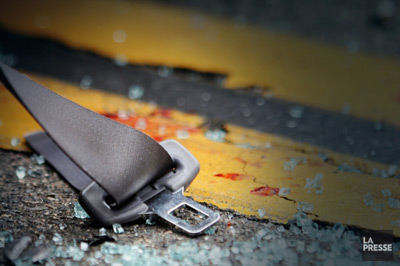2014 Honourable Mention

Additional Team Members
Sylvain Gilbert – Statisticien/Statistician
Rhys Halsey-Watkins – Intégrateur Web/Web Designer and Integrator
Thomas de Lorimier – Chef de division, production Web/Web Production Manager
 In a groundbreaking operation that not even the Ministry of Transport had ever conducted, the La Presse team set out to pinpoint the exact geographic location of thousands of serious accidents suffered on Quebec’s roads and highways that every year claim 500 lives and account for thousands of serious injuries.
In a groundbreaking operation that not even the Ministry of Transport had ever conducted, the La Presse team set out to pinpoint the exact geographic location of thousands of serious accidents suffered on Quebec’s roads and highways that every year claim 500 lives and account for thousands of serious injuries.
The team mapped out all of the 15,000 serious road accidents that occurred between 2006 and 2011 based on a massive database of police reports written up for every accident, obtained through the Access to Information Act.
What they found was striking: hundreds of “hot spots” that, until then, had managed to elude the public’s radar. In many cases, the culprit was the road itself, often the result of poor design or poor maintenance.
The investigation revealed, for example, that three out of the four ramps of a highway interchange used by more than 230,000 motorists a day do not meet Quebec standards. This site posted the highest number of serious or fatal accidents in the six-year period.
They also discovered a 26-kilometre span of country highway that saw 13 fatalities and 36 serious injuries resulting from road accidents that locals go out of their way to avoid. Thanks to this report, Quebec finally agreed to modify the signage.
Whereas the government claimed photo radar devices were positioned on the basis of strict criteria including accident severity, the reporting found otherwise: few and in some cases no fatal or serious accidents had occurred at the sites chosen for placement of photo radar technology, and locations where a high incidence of serious accidents occurred remain, to this day, without a radar detector.
“Roads that Kill” is a powerful, original series. The team used freedom of information laws to gather raw data, studied it, charted it on maps, and brought in engineers, urban planners and a racecar driver to help explain why there were so many serious accidents on Quebec roads and highways. La Presse committed many resources to look at a failure in our system that no one had ever thought about before. It was original rather than reactive, had big impact and took the print medium to a whole new level with their extensive use of maps and graphics that made the information accessible to a wider range of people. Confronted with so much damning information, the government promised to take action.
Having graduated with a bachelor’s degree in Journalism from UQAM, Gabrielle Duchaine began her journalism career in 2006 at the Journal de Montréal before moving to RueFrontenac.com. She subsequently wrote for a number of magazines including l’Actualité, Québec Sciences, and Les Affaires. She joined La Presse in 2012 as a news reporter focusing on social issues. Gabrielle has won several awards including the Judith-Jasmin Award in the Investigative journalism category, the Arthur-Prévost bursary of the Fédération professionnelle des journalistes, which is awarded in recognition of the remarkable quality of work of a reporter at the start of his/her career, and a prize honouring the best coverage of a Breaking News story awarded by the National Newspaper Award.
Having graduated with a bachelor’s degree in Journalism from UQAM, Caroline Touzin has been a reporter for La Presse since 2004. In 2005, she received the Edward Goff Penny Memorial Prize, which is awarded to the best Young Journalist in Canada.

